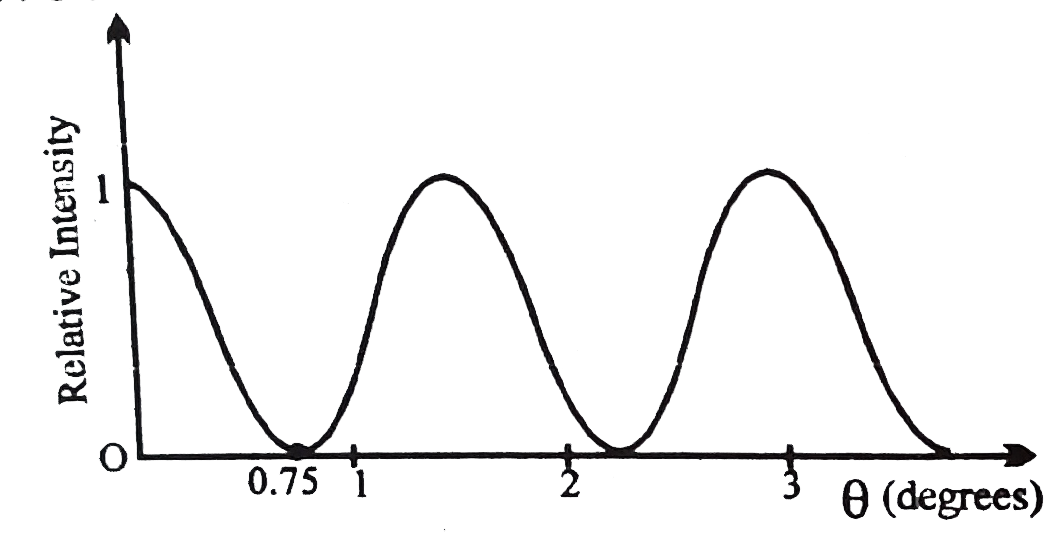Light of wavelength 520nm passing through a double slit,produced interference pattern of relative intensity versus deflection angle θ as shown in the figure.find the separation of between the slits.

The correct Answer is:1.98×10−2mm
Step by step video & image solution for Light of wavelength 520nm passing through a double slit,produced interference pattern of relative intensity versus deflection angle theta as shown in the figure.find the separation of between the slits. by Physics experts to help you in doubts & scoring excellent marks in Class 12 exams.
Updated on:21/07/2023Topper's Solved these Questions
- WAVE OPTICSBOOK - ALLENCHAPTER - WAVE OPTICSEXERCISE - Exercise 4 B (Conceptual subjective Exercise)
8 Videos
- WAVE OPTICSBOOK - ALLENCHAPTER - WAVE OPTICSEXERCISE - Exercise 5 A (Previous Years Questions)
17 Videos
- WAVE OPTICSBOOK - ALLENCHAPTER - WAVE OPTICSEXERCISE - Exercise 3 (Miscellaneous type Questions)
27 Videos
- UNIT & DIMENSIONS, BASIC MATHS AND VECTOR BOOK - ALLENCHAPTER - UNIT & DIMENSIONS, BASIC MATHS AND VECTOR EXERCISE - Exercise (J-A)
7 Videos
Similar Questions
Suppose a monochromatic X-ray beam of wavelength 100 pm is sent through a Young's double slit and the interference pattern is observed on a photographic plate placed 40 cm away from the slit. What should be the separation between the slits so that the successive maxima on the screen are separated by a distance of 0.1 mm?
View SolutionLaser light of wavelength 1260 nm incident on a pair of slits produces an interference pattern in which the fringes are seprated by 8.1mm .A second laser light produces an interference pattern in which the fringes are seprated by 7.2 mm.Calculate the wavelength of the second light
View Solution
Knowledge Check
In a double slit interference pattern, the first maxima for infrared light would be
Aat the same place as the first maxima for green lightBcloser to the centre than the first maxima for green lightCfarther from the centre than the first maxima for green lightDinfrared light does not produce an interference pattern
Laser light of wavelength 630nm incident on a pair of slits produces an interference pattern where bright fringes are separated by 8.1mm. Another light produces the interference pattern, where the bright fringes are separated by 7.2mm. Calculate the wavelength of second light.
View SolutionLaser light of wavelength 315 nm incident on a pair of slits produces an interference pattern in which the fringes are seprated by 8.1mm .A second laser light produces an interference pattern in which the fringes are seprated by 7.2 mm.Calculate the wavelength of the second light
View SolutionLaser light of wavelength 630 nm incident on a pair of slits produces an interference pattern in which the fringes are seprated by 8.1mm .A second laser light produces an interference pattern in which the fringes are seprated by 3.6 mm.Calculate the wavelength of the second light
View SolutionLaser light of wavelength 630 nm incident on a pair of slits produces an interference pattern in which the fringes are seprated by 8.1mm .A second laser light produces an interference pattern in which the fringes are seprated by 7.2 mm .calculate the wavelength of the second light .
View SolutionA source emitting light of wavelengths 480 nm and 600 nm is used in a double slit interference experiment. The separation between the slits is 0.25 mm and the interference is observed on a screen placed at 150 cm from the slits. Find the linear separation between the first maximum (next to the central maximum) corresponding to the two wavelengths.
View SolutionLaser light of wave length 600 nm incident on a pair of slits produces an interference pattern in which the bright fringes are separated by 8mm. A second light produces an interference pattern in which the fringes are separated by 12 mm. Calculate the wavelength of the second light.
View SolutionIn the Young's double slit experiment, the interference pattern is found to have as intensity ratio between the bright and dark fringes as 9. This implies that
View Solution
